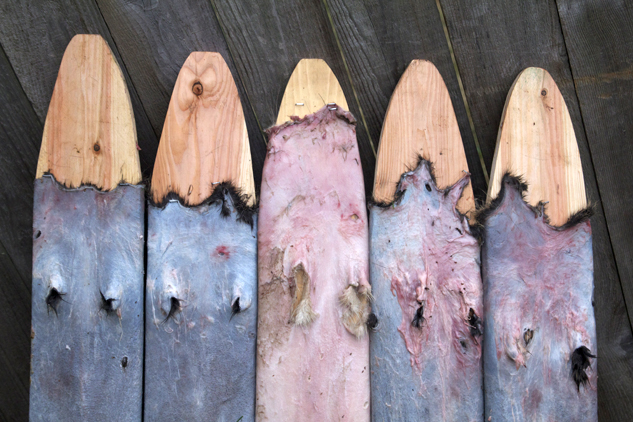Wet-Scraping Nutria Hides With Bone and Stone Tools
So, I have a friend who has property and it is over-run with nutria. About three times a year he will go around and shoot as many nutria as he can see. This may seem cold, but nutria are an invasive species of aquatic rodent brought here during the fur trade era and released when it crashed. They have a native relative, the muskrat. Unfortunately for the muskrat, the nutria breeds three times a year as opposed to the muskrat’s once a year. They have been taking over muskrat habitat and doing a lot of damage, even moreso than the beaver, who can cut down entire trees with its teeth. So, yeah. In the spirit of my work with Rewild Portland, doing ancestral skills with invasive species like English Ivy and Himalayan Blackberry, it was only a matter of time before we made the leap to mammals. Nutria is the most obvious starting place there.
I’ve had 11 hides in the freezer for a couple months after the last batch of my friends nutria killing spree. The summer is the best time to tan hides because of the heat, so I figured it was now or never! I made a few hide boards since it seems like a heck of a lot less work than racking all 11 hides. It seems to be working well. I used this old trapper’s guide to make the boards. I’ve tanned hides before, but not nutria. To freshen my memory and get some tips I read up on my old friend Sassmouth’s blog on nutria tanning. We case skinned the nutria but didn’t keep the faces on most of them, so I had to staple the hides at the top while scraping them. In the future I think I will definitely save the faces, when I got this last batch I didn’t have time to do the delicate work on skinning the face so I just cut their heads off.
Here are the tools I was using to scrape the flesh, fat, and what I could of the membrane. There is a deer leg adz on the top (made from a metacarpal which is displayed on the left). This adz is rounded and dull. It works amazing in the spots the drawknife just can seem to peel. An elk metacarpal split down the center for a drawknife is on the bottom. This tool does the meat of the work (pun intended). In the middle are three basalt flakes from the Columnar Basalt that I am smitten with at the moment. These are for scraping even harder to scrape pieces that the bones won’t take. I pressure flaked a serrated edge on a couple of them to cut off the tough stringy bits of membrane and flesh. I tried these tools for a bit and then switched to a metal drawknife. I quickly went back to the “primitive” tools when the drawknife tore through the flesh in a couple spots. It was just too hard of a tool. The bone and stone tools worked much better so I did the rest with them.
Here are some photos of me working the hide. I would normally do a pipe or log for wet-scrape, but this flat edge on the bone worked well on this flat board. I also am not a fan of this particular set up. I wish the boards were longer so that I could stand. I prefer this position of fleshing rather than the pushing away method. I forget what they are called at the moment.
After the first hide I figured out the best way of going about getting a clean scrape. I would start with the adz and delicately peel away a nice layer all the way around and all the way to the hide and then switch to the drawknife for the rest, except for those tough spots which I used my adz and basalt tools.
Sometimes that membrane around the face or the chest/arms just doesn’t want to come off. Here is an example of what it can look like. The middle is just glued in there! This one was the one my friend Kelila was working on, so maybe it was just her. Zing!
Here is what it should look more like:
Sometimes you find treasures in the flesh… Here are two bullets that I pulled from the same animal. I hope they had a swift end and I am thankful to use their skins.
Never work on hides alone! It’s always more fun with friends. Here is Kelila making a funny face as she tries to remove the sticky membrane from the front.
The slugs already started helping me clean up all the fleshy bits in my yard!
Half way done!













Hi Peter,
Great photos, showing how one tans a Nutria!
Any plans on what you will create once the entire process is complete?
Cheers!
Christine
Hi Peter,
Made an error, I see that the tanning is yet to come and something to look forward to during the summer months. Sorry about that.
Great job with your photos Peter, showing how one wet-scraps Nutria hide.
Cheers 🙂
Christine